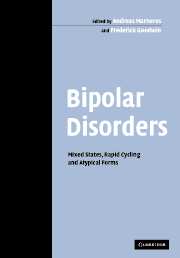Book contents
- Frontmatter
- Contents
- List of contributors
- Preface
- 1 Bipolar disorders beyond major depression and euphoric mania
- 2 Emerging concepts of mixed states: a longitudinal perspective
- 3 Rapid-cycling bipolar disorder
- 4 Bipolar I and bipolar II: a dichotomy?
- 5 Recurrent brief depression as an indicator of severe mood disorders
- 6 Atypical depression and its relation to bipolar spectrum
- 7 Agitated depression: spontaneous and induced
- 8 Schizoaffective mixed states
- 9 Acute and transient psychotic disorder: an atypical bipolar disorder?
- 10 Bipolar disorder in children and adolescents
- 11 Atypical features of bipolarity in old age
- 12 Comorbidity in mixed states and rapid-cycling forms of bipolar disorders
- 13 Challenges in the genetics of bipolar disorder
- 14 Biological aspects of rapid-cycling and mixed states
- 15 The treatment of bipolar mixed states
- 16 The use of atypical antipsychotic agents in the treatment of diagnostic subgroups of bipolar disorder: mixed and pure states, psychotic and non-psychotic
- 17 Investigational strategies: treatment of rapid cycling, mixed episodes, and atypical bipolar mood disorder
- Index
- References
14 - Biological aspects of rapid-cycling and mixed states
Published online by Cambridge University Press: 10 August 2009
- Frontmatter
- Contents
- List of contributors
- Preface
- 1 Bipolar disorders beyond major depression and euphoric mania
- 2 Emerging concepts of mixed states: a longitudinal perspective
- 3 Rapid-cycling bipolar disorder
- 4 Bipolar I and bipolar II: a dichotomy?
- 5 Recurrent brief depression as an indicator of severe mood disorders
- 6 Atypical depression and its relation to bipolar spectrum
- 7 Agitated depression: spontaneous and induced
- 8 Schizoaffective mixed states
- 9 Acute and transient psychotic disorder: an atypical bipolar disorder?
- 10 Bipolar disorder in children and adolescents
- 11 Atypical features of bipolarity in old age
- 12 Comorbidity in mixed states and rapid-cycling forms of bipolar disorders
- 13 Challenges in the genetics of bipolar disorder
- 14 Biological aspects of rapid-cycling and mixed states
- 15 The treatment of bipolar mixed states
- 16 The use of atypical antipsychotic agents in the treatment of diagnostic subgroups of bipolar disorder: mixed and pure states, psychotic and non-psychotic
- 17 Investigational strategies: treatment of rapid cycling, mixed episodes, and atypical bipolar mood disorder
- Index
- References
Summary
Introduction
Despite the fact that rapid cycling and mixed states are common manifestations of bipolar disorder (Kilzieh and Akiskal, 1999; Akiskal et al., 2000; Grunze et al., 2002a) they have very rarely been subjects of interest for clinical and basic research. As far as clinical research is concerned, rapid cycling and mixed state traditionally were exclusion criteria for controlled randomized phase III studies. This changed just recently, where antiepileptics such as lamotrigine (Calabrese et al., 2000) were tested for their prophylactic efficacy in rapid-cycling patients. As far as mixed states are concerned, recent trials on modern antipsychotics (Keck et al., 2003; Sachs et al., 2002; Tohen et al., 2002) also allowed mixed patients in these studies.
A major problem for including mixed states in studies is the lack of a generally excepted definition. The Diagnostic and Statistical Manual of Mental Disorders, 4th edn (DSM-IV) criteria (fulfillment of all criteria of mania and typical depression at the same time: American Psychiatric Association, 1994) are too narrow, as it has been shown in retrospective analysis of the valproate mania study (Bowden et al., 1994) that one depressive syndrome predicts inferior responsiveness to lithium and better response to valproate (Swann et al., 1997). A commonly used definition is the so-called Cincinnati criteria, which require at least three relevant depressive syndromes (McElroy et al., 1992); however, again, a general consensus on how to define mixed states has not yet been achieved as other views may also have clinical advantages (Perugi et al., 1997).
Keywords
- Type
- Chapter
- Information
- Bipolar DisordersMixed States, Rapid Cycling and Atypical Forms, pp. 311 - 323Publisher: Cambridge University PressPrint publication year: 2005
References
- 1
- Cited by



